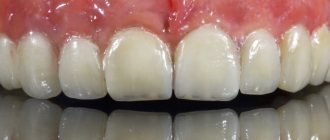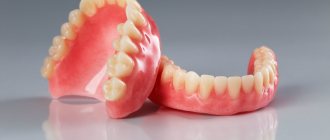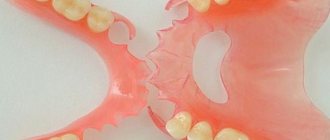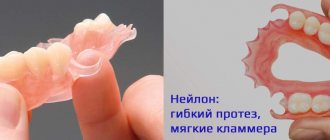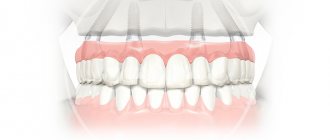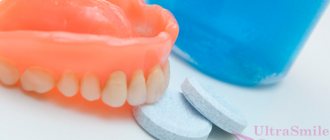Chief editor of the site:
Snitkovsky Arkady Alexandrovich
Chief physician of the professorial dentistry “22 Century”, dentist, orthopedic dentist
Author of the article:
Scientific team of dentistry “22 Century”
Dentists, candidates and doctors of medical sciences, professors
In modern orthopedic dentistry, high-quality materials and advanced technologies are used to manufacture removable dentures. Meanwhile, like any other medical procedure, the procedure for dental prosthetics can lead to complications.
Basic Concepts
Plate dentures
Removable structures include plate and clasp dentures.
Plate dentures, in turn, are partial removable and complete removable.
Partial removable laminar dentures are used when one or more teeth are missing.
Complete removable plate dentures are indicated in the absence of teeth in the upper and/or lower jaw.
A partial denture is a partial removable denture consisting of artificial teeth, artificial gums and special fastening elements (hooks, locks).
Why can complications arise after the installation of removable dentures?
- Poor preparation for prosthetics. Before treatment, it is necessary to carry out sanitation of the oral cavity, restoration, and more often, prosthetics of teeth, which will serve as a support for fixing the prosthesis;
- Insufficient oral hygiene. Can lead to inflammation of the gums under the prosthesis, the formation of caries, pulpitis of the teeth that serve as support for the prosthesis;
- Fracture of the prosthesis. As a result of breakage or displacement of parts of the prosthesis, its fixation in the oral cavity is disrupted, discomfort and pain occur when wearing it;
- Inaccurately manufactured prosthesis. The design should be easily fixed and also removed without much effort. There should be no gaps in the oral cavity between the structure and the gum, but the prosthesis should not put pressure or rub soft tissues. In the first case, food debris will accumulate in the gap, in the second, sores will appear on the mucous membrane, and subsequently bedsores;
- Changes in the position of individual teeth and bite, leading to displacement of the prosthesis.
Recovery period
Full recovery and healing of the gums may occur in a few days or weeks. To make the recovery process quick and comfortable, you must follow the following recommendations:
- For pain relief, take pain relievers as prescribed by your doctor, such as Tylenol or Advil;
- Do not take Aspirin under any circumstances, its active substances can cause bleeding;
- give up solid, hot and spicy foods for several days;
- give up cigarettes and alcoholic beverages;
- minimize active physical activity;
- Follow your doctor's advice about brushing your teeth while the tissue is healing.
Complications after dental prosthetics
- Sores and chafing after installation of dentures;
- Inflammatory process on the gums under dentures. Stomatitis;
- Diseases of supporting teeth (caries, pulpitis, periodontitis, etc.);
- Allergy to materials used to create prostheses;
- Galvanic syndrome;
- Loosening the fixation of removable structures;
- Changing the position of the cheeks and lips.
Let's look at each of the complications in more detail.
Sores and chafing after installation of dentures
A common phenomenon, especially typical for removable structures.
Symptoms
- Unpleasant sensations, pain while eating;
- Feeling of a foreign body in the mouth;
- Profuse salivation.
Treatment
The next day after the installation of a removable structure, there is always a follow-up appointment at the dentist's office. Regardless of the presence or absence of unpleasant sensations, it is necessary to come to the clinic for an examination, otherwise, if this is not done, bedsores will form .
If necessary, the doctor will correct the prosthesis and set a date for the next visit. At least two amendments are required for everyone.
During the first two to three weeks, you get used to the dentures, and discomfort is completely normal. Full adaptation usually occurs by the end of the third week.
Prosthetic stomatitis
Prosthetic stomatitis
One of the most common complications.
Symptoms
- In the first time after installing the prosthesis, in addition to discomfort, excessive pressure on the mucous membrane and pain are felt. Redness of the gums appears, and possibly the formation of pustules on the mucous membrane. Small blood vessels are pinched, and the blood supply to the tissues is disrupted at the site of contact - bedsores form;
- The fixing elements of partial dentures can also irritate the surrounding periodontal tissues and contribute to their inflammation.
Treatment
It is necessary to visit your doctor, who will carry out antiseptic treatment of the oral cavity and dentures, prescribe local anti-inflammatory therapy (rinses, mouth baths, ointments, gels), as well as a set of procedures aimed at accelerating tissue regeneration.
Diseases of supporting teeth
In the case of partial dentures, there are teeth in the oral cavity that perform the important function of supporting and securing the denture. Whether the supporting teeth are healthy, covered with crowns or restored with fillings, in any case it is necessary to take care of it and maintain hygiene of the entire oral cavity.
Symptoms
- Visible accumulations of food debris, plaque on teeth, as well as on removable structures;
- Unpleasant odor from the mouth and from the prosthesis;
- Bleeding gums around supporting teeth;
- Painful sensations during meals, from temperature stimuli, night pain.
Treatment and prevention
- Maintain regular and thorough care of dentures and teeth;
- Visit a doctor for professional oral hygiene;
- If pain occurs during chewing, as well as aching, sharp pain, contact your dentist.
Allergy to dentures
Allergy to dentures
An allergic reaction to denture materials can occur when the dentures come into contact with the tissues of the patient's body.
Currently, scientists are trying to minimize the occurrence of such reactions, and today many different materials for the manufacture of removable dentures.
The rate of occurrence of an allergic reaction can vary - from several minutes to several hours, and sometimes days after installation of the prosthesis.
Symptoms
- Rashes on the skin of the face;
- Redness and swelling of the oral mucosa;
- Attacks of bronchial asthma. Suffocation;
- Inflammation of the salivary glands;
- Dry mouth;
- Burning sensation of tongue.
Treatment
- Remove dentures;
- Contact an orthopedic dentist as soon as possible;
- Carry out repeated prosthetics with structures made of a different material.
Galvanic syndrome
This complication after prosthetics is the formation of galvanic current in the oral cavity.
The cause of the occurrence is the presence of dissimilar metals in all structures installed in the oral cavity (for example, used as the base of a prosthesis and as part of crowns) if a particular patient is predisposed to this disease.
In modern dentistry, in the manufacture of dentures, metals and their alloys are used, such as stainless steel, cobalt-chrome, silver-palladium alloys, alloys based on precious metals and others.
It is known that any alloy immersed in an electrolyte solution (in this case, saliva acts as this) acquires a potential unique to it. If metals with different potentials are present in the patient’s oral cavity, then all the conditions necessary for the formation of galvanic current arise.
Symptoms
- Unpleasant sensations while eating;
- Metallic taste in the mouth;
- A bitter and acidic taste in the mouth, especially aggravated when a metal spoon touches the dentures;
- Headache;
- Sleep disorders;
- General malaise;
- Allergic manifestations on the oral mucosa (swelling, erosion);
- Darkening of metal prostheses.
Treatment
- Repeated prosthetics, excluding the presence of dissimilar metals in the oral cavity.
Loosening the fixation of removable structures
Weakening of fixation of removable structures
This complication develops gradually, as the design of lamellar prostheses approaches the end of their service life.
In the case of clasp prosthetics, it is also possible for the plastic parts of the locking prostheses to wear off and the clasps to loosen .
Causes
- Daily use, regular removal from the oral cavity, changes in the anatomical structure of the prosthetic bed (loss of bone tissue with age).
Symptoms
- Sensation of displacement, movement of the prosthesis in the mouth;
- Lack of adherence of the prosthesis to the gums and teeth;
- Loss of structures from the mouth during eating and talking.
Treatment
- Making a new removable denture;
- Using special dental adhesives for fixation.
Correction of fastenings, relining of the prosthesis
Correction of fastenings, relining of the prosthesis
Relining of the prosthesis - correction, restoration of a removable structure in order to obtain a denture base adapted to chewing pressure, clarifying its fit to the prosthetic bed.
Over time, atrophy of the mucous and bone tissue occurs under the base of the removable denture. Atrophy leads to uneven distribution of chewing pressure between the supporting teeth (if any) and the mucous membrane. Failure to reline a removable denture can lead to its breakage and loss of supporting teeth.
Relining can take place either directly in the patient's mouth or in the laboratory.
Method of relining a removable denture in the clinic
- The dentist removes a thin layer of plastic from the surface of the prosthesis adjacent to the mucous membrane of the prosthetic bed and applies an even layer of self-hardening plastic to the treated base. After some time, the prosthesis is inserted into the oral cavity, installed and pressed, after which the patient closes his jaws. Excess plastic is removed with a spatula. After this, the prosthesis is removed and placed in a special apparatus, where the final polymerization of the plastic (hardening) takes place;
- Changing the position of the cheeks and lips.
Causes
- Errors at the stages of prosthesis manufacturing: excessive or insufficient thickness of the base in the frontal region, incorrect determination of the height of the lower third of the face and the centric relation of the jaws, inaccurate placement of artificial teeth in the base of the prosthesis.
Symptoms
- “Failed” or, conversely, excessively protruded lips;
- Biting cheeks with removable dentures;
- Deep nasolabial folds;
- Drooping corners of the mouth;
- The ability to close your lips only with force, while in a relaxed state your teeth are visible;
- Feeling of tightness in the cheeks.
Sections
- What is removable dental prosthetics?
- Indications and contraindications for the procedure
- Materials for removable dental prosthetics
- Types and prices of removable dental prosthetics
- Stages of complete removable dentures
- Equipment of dental clinics "Zubastic" for removable dental prosthetics
- Advantages of removable dental prosthetics in our clinic
- Registration for removable dental prosthetics in Moscow
- Types of removable prosthetics
How to quickly get used to a removable denture: advice from orthopedic dentists
- Immediately after receiving the design, you should practice putting on and taking off the prosthesis yourself.
- When first using the product, you should not eat very hard foods; the load on the structure must be increased gradually. However, solid food still needs to be cut into pieces, avoiding biting.
- You cannot remove the prosthesis and put it on again after some time. The structure should be removed from the mouth only for hygiene procedures.
- If the material of the product rubs the mucous membrane and causes pain, you should not file it yourself - you should consult a dentist. A few hours before your visit to the doctor, the prosthesis will have to be put back on so that the orthopedist can see exactly where the friction is occurring. In total, 2-3 such visits may be needed to correct the structure.
- To eliminate pain and prevent inflammation, you should use special dental gels (as recommended by your doctor).
- If a removable denture causes you to vomit, you should not remove it immediately. Over time, the discomfort will pass. Some people find mint lozenges and saline mouth rinses very helpful.
- If signs of poor diction appear, you should perform special exercises, talk more, and read aloud.
Getting used to removable dentures occurs much faster if the denture is not the patient’s first. Usually 3-5 days are enough.
Troubleshooting methods
The list of techniques used to ensure the seating density of the replacement structure includes:
- Adjustment of configuration and replacement of fixing elements;
- Use of adhesives;
- Implantation of mini-implants;
- Complete replacement of the prosthesis.
In some cases, it is possible to avoid adjusting the prosthesis - to do this, it is necessary to teach the patient how to control the masticatory muscles. Proper biting and chewing of food ensures even distribution of the load, which eliminates the possibility of displacement of the replacement structure.
Doctors' opinions on removable dentures
Modern dentistry has advanced significantly. Today, prosthetics with removable clasp and other types of prostheses are viewed more as a temporary measure. It is advisable to install such dentures even if there are contraindications to wearing fixed products or performing dental implantation.
Doctors advise installing structures for adults and children who have lost teeth in order to prevent the displacement of dental units. In pediatric dentistry, such devices prevent the development of malocclusion pathologies and other problems associated with the premature loss of baby teeth.
Obviously, this type of prosthesis deserves attention in certain clinical cases. Sometimes removable products become the only real opportunity to restore lost teeth, and with them the opportunity to live a full life.
